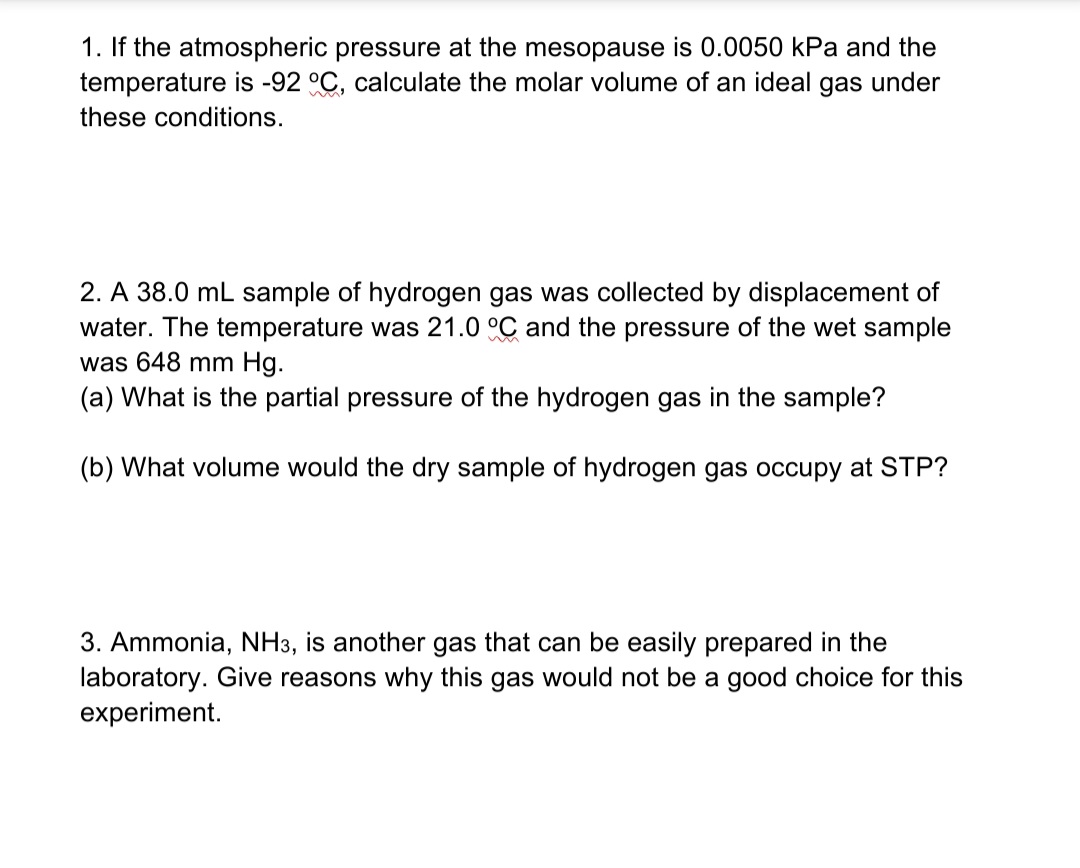1. If the atmospheric pressure at the mesopause is 0.0050 kPa and the temperature is -92 °C, calculate the molar volume of an ideal gas under these conditions. 2. A 38.0 mL sample of hydrogen gas was collected by displacement of water. The temperature was 21.0 °C and the pressure of the wet sample was 648 mm Hg. (a) What is the partial pressure of the hydrogen gas in the sample? (b) What volume would the dry sample of hydrogen gas occupy at STP? 3. Ammonia, NH3, is another gas that can be easily prepared in the laboratory. Give reasons why this gas would not be a good choice for this experiment.
1. If the atmospheric pressure at the mesopause is 0.0050 kPa and the temperature is -92 °C, calculate the molar volume of an ideal gas under these conditions. 2. A 38.0 mL sample of hydrogen gas was collected by displacement of water. The temperature was 21.0 °C and the pressure of the wet sample was 648 mm Hg. (a) What is the partial pressure of the hydrogen gas in the sample? (b) What volume would the dry sample of hydrogen gas occupy at STP? 3. Ammonia, NH3, is another gas that can be easily prepared in the laboratory. Give reasons why this gas would not be a good choice for this experiment.
Introduction to Chemical Engineering Thermodynamics
8th Edition
ISBN:9781259696527
Author:J.M. Smith Termodinamica en ingenieria quimica, Hendrick C Van Ness, Michael Abbott, Mark Swihart
Publisher:J.M. Smith Termodinamica en ingenieria quimica, Hendrick C Van Ness, Michael Abbott, Mark Swihart
Chapter1: Introduction
Section: Chapter Questions
Problem 1.1P
Related questions
Question
Experiment: determination of molar volume of gas at STP

Transcribed Image Text:1. If the atmospheric pressure at the mesopause is 0.0050 kPa and the
temperature is -92 °C, calculate the molar volume of an ideal gas under
these conditions.
2. A 38.0 mL sample of hydrogen gas was collected by displacement of
water. The temperature was 21.0 °C and the pressure of the wet sample
was 648 mm Hg.
(a) What is the partial pressure of the hydrogen gas in the sample?
(b) What volume would the dry sample of hydrogen gas occupy at STP?
3. Ammonia, NH3, is another gas that can be easily prepared in the
laboratory. Give reasons why this gas would not be a good choice for this
experiment.
Expert Solution
This question has been solved!
Explore an expertly crafted, step-by-step solution for a thorough understanding of key concepts.
Step by step
Solved in 3 steps

Knowledge Booster
Learn more about
Need a deep-dive on the concept behind this application? Look no further. Learn more about this topic, chemical-engineering and related others by exploring similar questions and additional content below.Recommended textbooks for you

Introduction to Chemical Engineering Thermodynami…
Chemical Engineering
ISBN:
9781259696527
Author:
J.M. Smith Termodinamica en ingenieria quimica, Hendrick C Van Ness, Michael Abbott, Mark Swihart
Publisher:
McGraw-Hill Education

Elementary Principles of Chemical Processes, Bind…
Chemical Engineering
ISBN:
9781118431221
Author:
Richard M. Felder, Ronald W. Rousseau, Lisa G. Bullard
Publisher:
WILEY

Elements of Chemical Reaction Engineering (5th Ed…
Chemical Engineering
ISBN:
9780133887518
Author:
H. Scott Fogler
Publisher:
Prentice Hall

Introduction to Chemical Engineering Thermodynami…
Chemical Engineering
ISBN:
9781259696527
Author:
J.M. Smith Termodinamica en ingenieria quimica, Hendrick C Van Ness, Michael Abbott, Mark Swihart
Publisher:
McGraw-Hill Education

Elementary Principles of Chemical Processes, Bind…
Chemical Engineering
ISBN:
9781118431221
Author:
Richard M. Felder, Ronald W. Rousseau, Lisa G. Bullard
Publisher:
WILEY

Elements of Chemical Reaction Engineering (5th Ed…
Chemical Engineering
ISBN:
9780133887518
Author:
H. Scott Fogler
Publisher:
Prentice Hall


Industrial Plastics: Theory and Applications
Chemical Engineering
ISBN:
9781285061238
Author:
Lokensgard, Erik
Publisher:
Delmar Cengage Learning

Unit Operations of Chemical Engineering
Chemical Engineering
ISBN:
9780072848236
Author:
Warren McCabe, Julian C. Smith, Peter Harriott
Publisher:
McGraw-Hill Companies, The